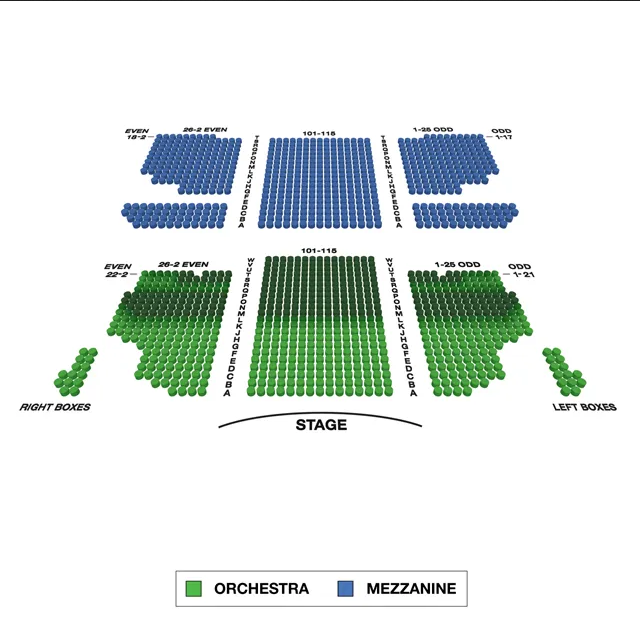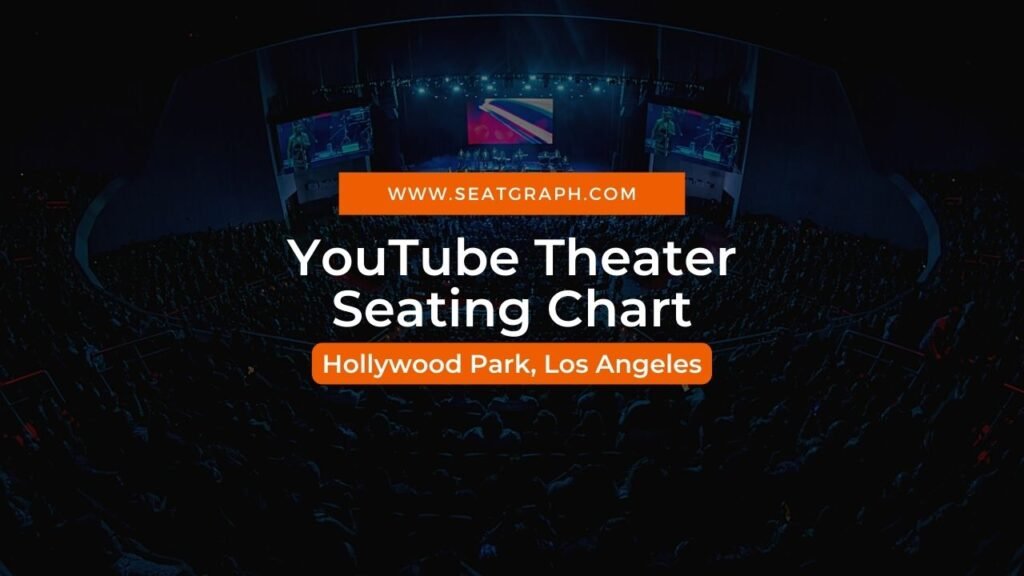The Al Hirschfeld Theatre seating chart offers a detailed view of the auditorium, including the location of all seating sections and the layout of rows and seat numbers. Use this chart to find the best seats for your budget and viewing experience at the Al Hirschfeld Theatre in New York City.
The Al Hirschfeld Theatre is a Broadway theater located at 302 West 45th Street in Manhattan, New York City. It was designed by architect G. Albert Lansburgh and opened on June 22, 1924, as the Martin Beck Theatre. The theater was renamed in 2003 to honor the legendary Broadway caricaturist Al Hirschfeld.
It has a seating capacity of 1,424 and is currently owned by the Jujamcyn theater company. The theater has been home to many notable productions, including “A Streetcar Named Desire,” “The Producers,” and “Kinky Boots.”
Al Hirschfeld Theatre Seating Chart

A breakdown of the different seating sections at the Al Hirschfeld Theatre
The Al Hirschfeld Theatre has four levels of seating: the orchestra, the mezzanine, the balcony, and the boxes.
The orchestra is the main floor level of the theater, and it is located closest to the stage. The mezzanine is the first level of seating above the orchestra, and it offers a good view of the stage. The balcony is the highest level of the theater, and it is located at the back of the theater. The gallery is a seating area located at the very back of the theater, above the balcony.
Here is a general seating chart for the Al Hirschfeld Theatre:
Orchestra: The orchestra section is located on the ground level of the theater and is the largest section, with a total of 835 seats. The section is divided into three sections: Left Orchestra, Center Orchestra, and Right Orchestra.
Mezzanine: The mezzanine is located above the orchestra and has a total of 297 seats. It is divided into Left Mezzanine, Center Mezzanine, and Right Mezzanine.
Balcony: The balcony is located above the mezzanine and has a total of 292 seats. It is divided into Left Balcony, Center Balcony, and Right Balcony.
Boxes: The theater has four boxes located on either side of the stage, with a total of 20 seats.
Please note that this is just a general seating chart and the actual layout may vary depending on the production. It’s always a good idea to check the specific seating chart for a production when purchasing tickets.
The best seats in the house: a guide to premium seating at the Al Hirschfeld Theatre
There are several types of premium seating options available at the Al Hirschfeld Theatre, including:
- Orchestra: These are the seats located on the main floor of the theater, closest to the stage. They offer the best views of the performance and tend to be the most in-demand and therefore the most expensive.
- Mezzanine: These are the seats located on the second level of the theater, above the orchestra. They offer a good view of the stage, although they may be slightly further from the action than the orchestra seats.
- Box seats: The Al Hirschfeld Theatre has private boxes located on either side of the orchestra section. These seats offer a more intimate and exclusive experience and often come with added perks such as wait service.
Tips for choosing the right seats at the Al Hirschfeld Theatre
A comparison of the Al Hirschfeld Theatre’s seating chart to other Broadway theaters
Every theater is different, and the seating layout can vary significantly from one venue to another. Here is a general comparison of the Al Hirschfeld Theatre’s seating chart to those of other Broadway theaters:
- The Al Hirschfeld Theatre has a seating capacity of 1,424, making it a medium-sized Broadway theater. It has an orchestra section and a mezzanine, as well as private boxes on either side of the orchestra.
- The Gershwin Theatre, another medium-sized Broadway theater, has a seating capacity of 1,933. It has an orchestra section, a mezzanine, and a balcony.
- The Imperial Theatre, a larger Broadway theater with a seating capacity of 1,435, has an orchestra section, a mezzanine, and a balcony. It also has box seats located on either side of the orchestra.
- The Belasco Theatre, a smaller Broadway theater with a seating capacity of 967, has an orchestra section and a mezzanine. It does not have a balcony or private boxes.
Accessibility options at the Al Hirschfeld Theatre
The Al Hirschfeld Theatre is committed to making its performances and facilities accessible to all patrons. Here are a few of the accessibility options available at the theater:
- Wheelchair accessible seating: The Al Hirschfeld Theatre has designated wheelchair accessible seating locations in the orchestra section. These seats can be easily reached by patrons using wheelchairs and offer good views of the stage.
- Assistive listening devices: The theater offers assistive listening devices to patrons who are deaf or hard of hearing. These devices amplify the sound of the performance and can be collected from the theater’s coat check.
- Accessibility services: The theater offers a range of accessibility services for patrons with disabilities, including sign language interpretation and audio description. Patrons should contact the theater’s box office in advance to request these services.
- Elevator access: The Al Hirschfeld Theatre has an elevator that provides access to all levels of the theater, including the orchestra and mezzanine.
If you have any specific accessibility needs, it’s a good idea to contact the theater’s box office in advance to ensure that your visit is as smooth and enjoyable as possible.
The view from different seats at the Al Hirschfeld Theatre

The view from different seats at the Al Hirschfeld Theatre can vary depending on the specific production and the layout of the stage. Here is a general overview of what you can expect from each seat section at the theater:
- Orchestra: These are the seats located on the main floor of the theater, closest to the stage. They offer the best views of the performance and tend to be the most in-demand and therefore the most expensive.
- Mezzanine: These are the seats located on the second level of the theater, above the orchestra. They offer a good view of the stage, although they may be slightly further from the action than the orchestra seats. In some cases, the mezzanine may be steeply raked, which can help improve the sight lines.
- Box seats: The Al Hirschfeld Theatre has private boxes located on either side of the orchestra section. These seats offer a more intimate and exclusive experience and often come with added perks such as wait service. The view from the box seats will depend on the specific location of the box, but they generally offer good sight lines to the stage.
The impact of stage setup on seating at the Al Hirschfeld Theatre
The stage setup at the Al Hirschfeld Theatre can have an impact on the view from different seats in the theater. Here are a few things to consider:
- Stage height: If the stage is set up higher off the ground, it can be more difficult to see the performance from the orchestra section, especially if you’re sitting towards the back. In these cases, mezzanine seats or box seats might offer a better view.
- Set design: The set design of a production can also affect the view from different seats. For example, if the set includes a lot of action in the center of the stage, seats towards the sides of the orchestra might have a partially obstructed view.
- Proscenium arch: The proscenium arch is the frame around the stage at the Al Hirschfeld Theatre. The height and width of the arch can affect the view from different seats in the theater. For example, if the arch is tall and narrow, it can obscure the view from seats towards the back of the orchestra.
The history of the Al Hirschfeld Theatre’s seating arrangements
The Al Hirschfeld Theatre is a historic Broadway theater located in Manhattan, New York City. It was designed by the architect G. Albert Lansburgh and opened on December 8, 1930 as the Martin Beck Theatre. It was renamed the Al Hirschfeld Theatre in 2003 in honor of the famous caricaturist Al Hirschfeld.
The theater’s original seating arrangement consisted of an orchestra section and a mezzanine. It also had a balcony, which was later removed in the 1950s to create a more intimate atmosphere. The theater has undergone several renovations over the years, but the basic layout of the orchestra and mezzanine has remained the same.
In recent years, the Al Hirschfeld Theatre has made efforts to improve accessibility for patrons with disabilities, including the installation of an elevator and the addition of designated wheelchair accessible seating in the orchestra section.
Frequently asked questions about the Al Hirschfeld Theatre’s seating chart
Here are a few frequently asked questions about the Al Hirschfeld Theatre’s seating chart:
How do I find the seating chart for a specific production at the Al Hirschfeld Theatre?
You can find the seating chart for a specific production at the Al Hirschfeld Theatre by visiting the theater’s website or by contacting the box office. The seating chart will usually be available closer to the opening date of the production.
Is there a dress code for the Al Hirschfeld Theatre?
There is no strict dress code at the Al Hirschfeld Theatre. Patrons are encouraged to wear comfortable clothing that is appropriate for the occasion.
Are there any discounts available for tickets to the Al Hirschfeld Theatre?
Discounts may be available for tickets to the Al Hirschfeld Theatre through various programs such as TKTS, student discounts, and group sales. You can check the theater’s website or contact the box office for more information about available discounts.
Can I bring food and drinks into the theater?
Food and drinks are generally not allowed inside the Al Hirschfeld Theatre. However, water is allowed and there are usually refreshments available for purchase at the theater.
Is there an age limit for performances at the Al Hirschfeld Theatre?
There is no specific age limit for performances at the Al Hirschfeld Theatre. However, some productions may not be suitable for young children due to themes or content. It’s always a good idea to check with the box office or read reviews of the production to get a better understanding of its appropriateness for children.



